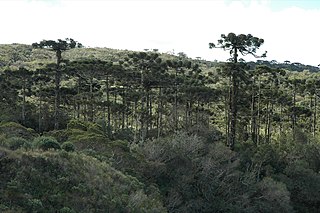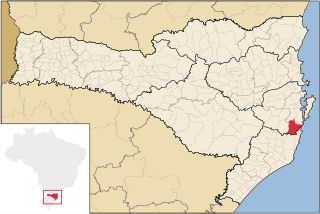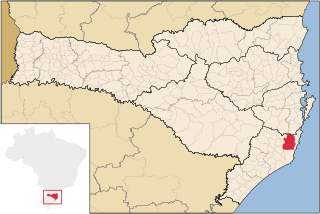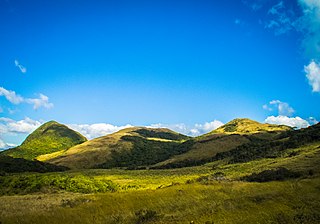Location
The Serra Furada State Park is divided between the municipalities of Orleans and Grão Pará, Santa Catarina. It has an area of 1,330 hectares (3,300 acres). The buffer zone covers 9,377 hectares (23,170 acres), with a perimeter of 77.5 kilometres (48.2 mi). The park's name is from a cleft in a sandstone rock about 45 metres (148 ft) high and 8 metres (26 ft) wide that can be seen from several kilometers away. The rock is most often viewed from the Morro da Igreja, the site of the air traffic control radar towers for southern Brazil.
The park is on the escarpment of the Serra Geral and covers parts of the Serra Geral and Botucatu geological formations. Altitudes vary from 400 to 1,480 metres (1,310 to 4,860 ft). There are steep cliffs in the highest areas and deep valleys created by strong fluvial erosion. There are rounded hills in areas where sedimentary rocks predominate. The park contributes to the sources of important local rivers such as the Minador River, a tributary of the Laranjeiras River, in turn a tributary of the Tubarão River, and the Meio and Braço Esquerdo Rivers that drain into the sub-basin of the Braço do Norte River.
The western portion of the park is adjacent to the 49,300 hectares (122,000 acres) São Joaquim National Park, which was created in 1961 in an effort to halt the devastation of the Araucaria pine forests of the region. The two parks together form a continuous forest area. The park has high tourist potential.
Environment
The air has high relative humidity of about 85%, and average annual rainfall is 1,500 millimetres (59 in). The warmest months are from December to March, with average maximum temperatures above 25 °C (77 °F). July is the coldest month, with average minimum temperature of 7.8 to 12.6 °C (46.0 to 54.7 °F).
The characteristic vegetation is dense rainforest of the Atlantic Forest biome, including submontane, montane and high montane formations. There are special types of pioneer vegetation in the extremely steep or vertical walls of the Serra Geral. The park is part of the core zone of the Atlantic Forest Biosphere Reserve. It protects rare and endangered forest species, unusual altitude vegetation, and primary forests of great importance for regeneration of the local forests. Initial studies during preparation of the Management Plan found 174 species of birds, 10 of mammals, 23 of amphibians, 14 of reptiles and 12 species of fish.
A road through the park provides the only access to three neighboring private properties, and conflicts with the park objectives. There is no tourist infrastructure. Visitors on the trail to the Serra Furada monument have created patches of bare earth, garbage, marks on tree trunks and graffiti on the rocks. Properties in the buffer zone are used for pig farming and eucalyptus plantations.

Palhoça is a municipality in Santa Catarina, Brazil.

Santa Catarina Island is an island in the Brazilian state of Santa Catarina, located off the southern coast. It is home to the state capital, Florianópolis.

Águas Mornas is a Brazilian municipality in the state of Santa Catarina.

The Araucaria moist forests, officially classified as mixed ombrophilous forest in Brazil, are a montane subtropical moist forest ecoregion. The forest ecosystem is located in southern Brazil and northeastern Argentina. The ecoregion is a southern portion of the Atlantic Forest. The ecoregion also includes select areas of open field called "campos de cima da serra" or "coxilhas".

Santo Amaro da Imperatriz, or simply Santo Amaro, is a municipality in Santa Catarina located close to the state capital Florianópolis and is connected to Palhoça by BR-282 in the northeast.

São Joaquim National Park is a National park in the state of Santa Catarina, Brazil.

Paulo Lopes is a municipality in the state of Santa Catarina in the South region of Brazil.

Orleans is a Brazilian municipality in the state of Santa Catarina. The town is located in the south of the state. As of 2020, the estimated population was 23,038.

The Cubatão River is a river of Santa Catarina state in southeastern Brazil.
The Laranjeiras River is a river of Santa Catarina state in southeastern Brazil. It is a left tributary of the Hipólito River, which in turn is a right tributary of the Braço do Norte River.

São Bonifácio is a municipality in the state of Santa Catarina in the South region of Brazil.

São Martinho is a municipality in the state of Santa Catarina in the Southern region of Brazil.

Imaruí is a municipality in the state of Santa Catarina in the South region of Brazil.

Grão-Pará is a municipality in the state of Santa Catarina in the South region of Brazil.

Serra do Tabuleiro State Park is a state park in the state of Santa Catarina, Brazil. It protects a mountainous area near the city of Florianópolis, covered in Atlantic Forest, which is an important source of drinking water. It also protects some coastal islands. The park is used for scientific research, education and eco-tourism.

The Vargem do Braço River is a river of the state of Santa Catarina, Brazil.
The D'Una River is a river of the state of Santa Catarina, Brasil.

Serra do Gandarela National Park is a national park in the state of Minas Gerais, Brazil. It protects a mountainous region holding a remnant of Atlantic Forest that is an important source of water for the city of Belo Horizonte.

The Rio Vermelho State Park Portuguese: Parque Estadual do Rio Vermelho is a state park in the state of Santa Catarina, Brazil. It protects an area of restinga, dense rainforest and land modified by exotic plantations which is to be restored. The park provides a green space for visitors from the nearby state capital of Florianópolis. It features an ecological trail where visitors may see and learn about wild animals rescued from abuse by the environmental police.
This page is based on this
Wikipedia article Text is available under the
CC BY-SA 4.0 license; additional terms may apply.
Images, videos and audio are available under their respective licenses.


















